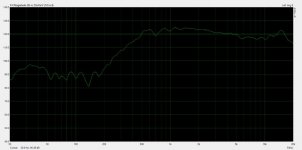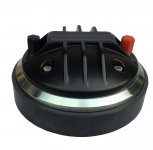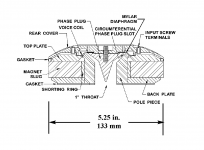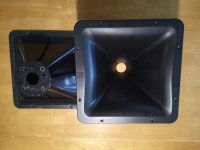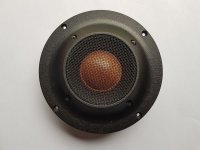It features a 4" diaphragm with Mylar suspension, does 20 kHz without major breakup issues and is available for about 1/6 of the price for a ND4015BE.
In fact, the RCF's output in the top octave is better than B&C's top of the line DE1090TN, which features a 3" diaphragm.
Members from the pro audio forums subjectively preferred the highs of the RCF to some 3" B&C drivers.
The RCF highs are perhaps more silky, but you can't beat physics, a 3" have a better efficiency in the highs and moreover need less equalization.
I do not see a reason why many these issues can't be partly negated by optimizing diaphragm/suspension and more importantly: phase plug design.
But agreed, if you want the best reproduction of the top octave, smaller is better.
A 2" diaphragm is probably the largest size that could reach 15kHz without major issues, a 0.75" diaphragm would do much better beyond that.
I don't care much for >15kHz, as long as breakup is reasonably damped, which appears to be the case with the RCF.
From memory: in the past the guy, who builds the wooden horn speakers, did experiments with BMS coaxials, but in the end preferred the RCF drivers.
But agreed, if you want the best reproduction of the top octave, smaller is better.
A 2" diaphragm is probably the largest size that could reach 15kHz without major issues, a 0.75" diaphragm would do much better beyond that.
I don't care much for >15kHz, as long as breakup is reasonably damped, which appears to be the case with the RCF.
From memory: in the past the guy, who builds the wooden horn speakers, did experiments with BMS coaxials, but in the end preferred the RCF drivers.
I do not see a reason why many these issues can't be partly negated by optimizing diaphragm/suspension and more importantly: phase plug design.
But agreed, if you want the best reproduction of the top octave, smaller is better.
A 2" diaphragm is probably the largest size that could reach 15kHz without major issues, a 0.75" diaphragm would do much better beyond that.
I don't care much for >15kHz, as long as breakup is reasonably damped, which appears to be the case with the RCF.
From memory: in the past the guy, who builds the wooden horn speakers, did experiments with BMS coaxials, but in the end preferred the RCF drivers.
For my specific application, i'm trying to keep the effciciency as high as technically possible in the whole band, my cheap Ti compressions are not well damped and ring before 15K... but i've decided to investigate on it before to put them in the trashcan and go for two more refined drivers.
After some Digital EQ, i've found a setting with only two points (notch filters) that turns these cheapos in some very refined sounding devices, at a point that i find them now better than my very hyped mylar compressions (reputed to be excellent in the treble)... the metal seems to be a better choice IMHO.
Last edited:
The RCF highs are perhaps more silky, but you can't beat physics, a 3" have a better efficiency in the highs and moreover need less equalization.
Compare the links and curves in previous posts.
I have yet to find a 3" driver of similar price that performs significantly better in the top octave than the RCF.
EQ is mostly dependent on the horn used. Evidently you could EQ some notches, but a well behaved top-end is to be preferred.
Last edited:
Compare the links and curves in previous posts.
I have yet to find a 3" driver of similar price that performs significantly better in the top octave than the RCF.
EQ is mostly dependent on the horn used.
Some people my smile at this but tune the sound of a horn system is more tricky that it appears

How can't be lost 😉
For my specific application, i'm trying to keep the effciciency as high as technically possible in the whole band, my cheap Ti compressions are not well damped and ring before 15K... but i've decided to investigate on it before to put them in the trashcan and go for two more refined drivers.
After some Digital EQ, i've found a setting with only two points (notch filters) that turns these cheapos in some very refined sounding devices, at a point that i find them now better than my very hyped mylar compressions (reputed to be excellent in the treble)... the metal seems to be a better choice IMHO.
Which 2 drivers are you referring to?
Are the "very hyped mylar compressions" perhaps DE250s?
Which 2 drivers are you referring to?
Are the "very hyped mylar compressions" perhaps DE250s?
Perhaps, i don't know, the labels are gone 😉
Last edited:
Thanks Chebum for your mdat. Here is an overlay 1/24 oct smoothing. I can't remember if my measurement was at 1m or horn mouth...
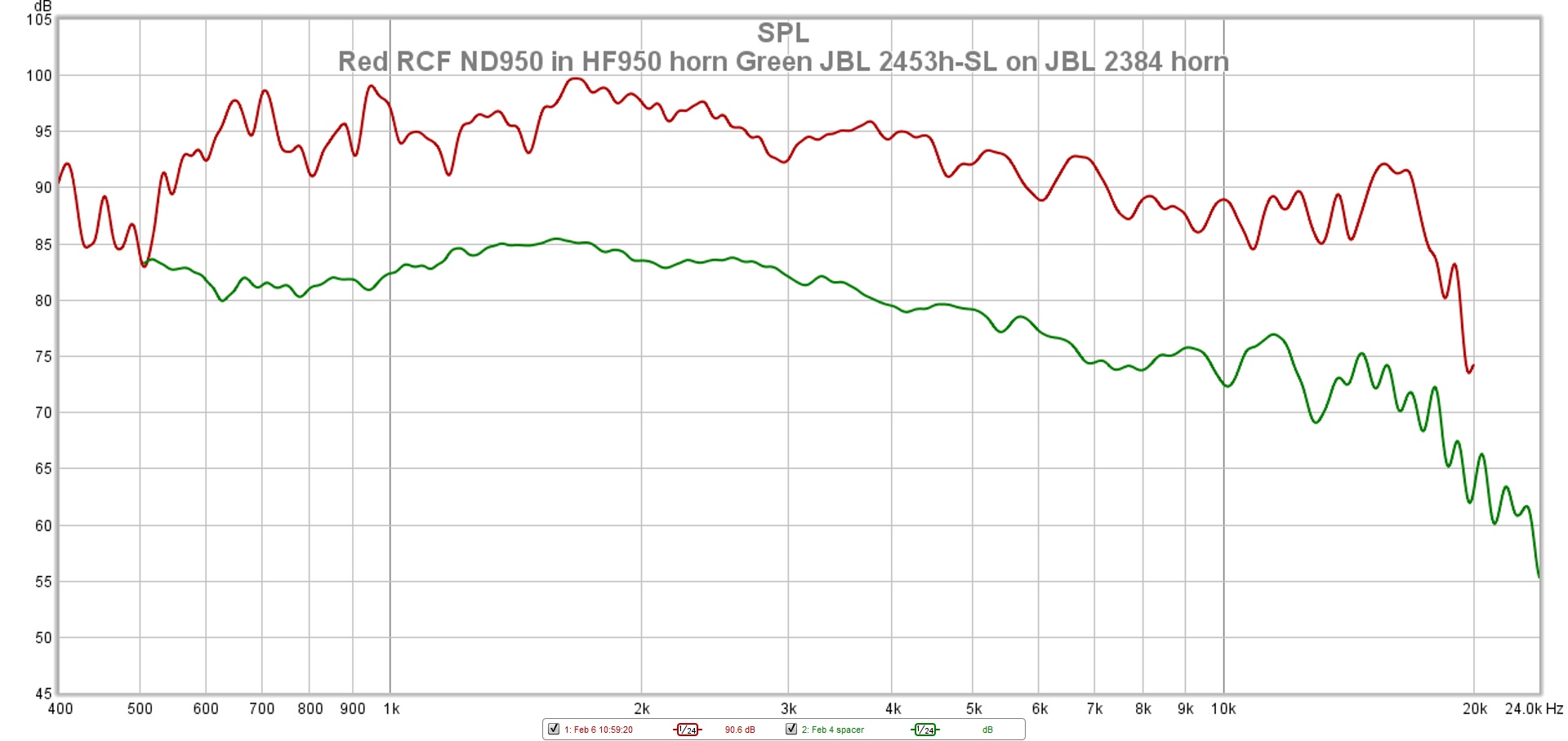
The JBL 2453h-SL is Ti aquaplased but still rings. It is not the best match for the JBL 2384 waveguide, even with a 1/2" spacer some anomaly exists at 12 kHz. I tried correcting it with DSP, but it made it worse (harsher sound). So I use DSP for digital XO and constant directivity eq and leave the top octave alone. Edit. the graph above is with no eq.
I am interested in finding the best horn CD combo from around 600 Hz on up...Cool thread.
The JBL 2453h-SL is Ti aquaplased but still rings. It is not the best match for the JBL 2384 waveguide, even with a 1/2" spacer some anomaly exists at 12 kHz. I tried correcting it with DSP, but it made it worse (harsher sound). So I use DSP for digital XO and constant directivity eq and leave the top octave alone. Edit. the graph above is with no eq.
I am interested in finding the best horn CD combo from around 600 Hz on up...Cool thread.
Attachments
Last edited:
wow the RCF ND950 2.0 looks to be worth the extra money over something like the P-Audio BM-D750. While using a 4" diaphragm it looks to have less breakup problems than the 3" diaphragm of the p-audio. If you look at the measurments here:
Tests: K-69-A driver on Edgar type wood Tractrix horn - Technical/Modifications - The Klipsch Audio Community
the k-69 (same as BM-D750) has bad breakup at ~14kHz(+12dB)
compare that with the earlier posted results for the RCF ND950 2.0:
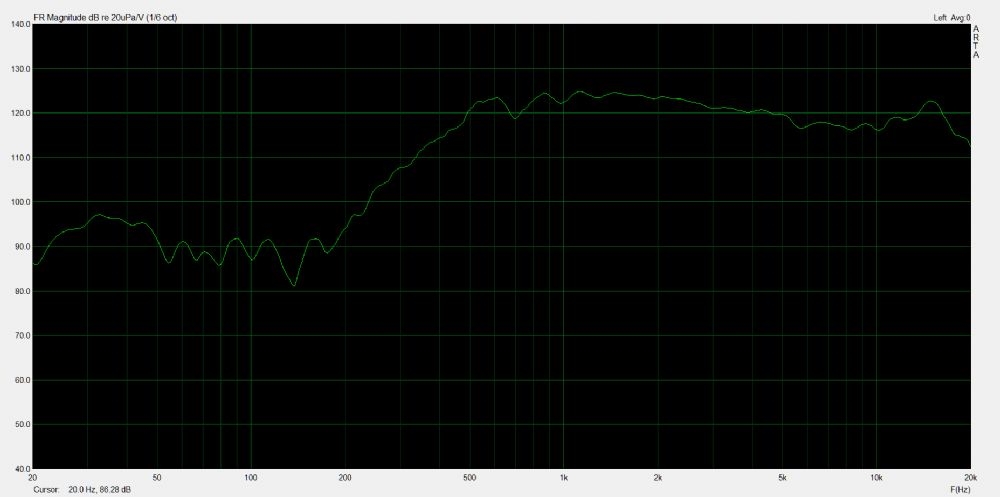
I'm seeing HF output only 10dB below peak and no high Q peaks caused by breakup.
Tests: K-69-A driver on Edgar type wood Tractrix horn - Technical/Modifications - The Klipsch Audio Community
the k-69 (same as BM-D750) has bad breakup at ~14kHz(+12dB)
compare that with the earlier posted results for the RCF ND950 2.0:
I'm seeing HF output only 10dB below peak and no high Q peaks caused by breakup.
20dB/division. 🙁
Probably, because of that RCF uses fir-based xover and DSP in their loudspeakers with ND950 compression driver. So do I🙂
The JBL 2453h-SL is Ti aquaplased but still rings. It is not the best match for the JBL 2384 waveguide, even with a 1/2" spacer some anomaly exists at 12 kHz. I tried correcting it with DSP, but it made it worse (harsher sound). So I use DSP for digital XO and constant directivity eq and leave the top octave alone. Edit. the graph above is with no eq.
I am interested in finding the best horn CD combo from around 600 Hz on up...Cool thread.
It's a well-known fact, serious breakup cannot be EQ-ed.
A mismatch near the throat, or even before the throat (exit > horn entrance) is often cause for "issues" around and beyond 10kHz.
Have you ever tried (some) PT horns, like these?:
Attachments
wow the RCF ND950 2.0 looks to be worth the extra money over something like the P-Audio BM-D750. While using a 4" diaphragm it looks to have less breakup problems than the 3" diaphragm of the p-audio.
The P-Audio BM-D750 is a nice budget 3" driver, basically a clone of the older B&C drivers I referred to earlier.
The RCF is in another league, incorporating modern R&D, materials and production technology.
Probably, because of that RCF uses fir-based xover and DSP in their loudspeakers with ND950 compression driver. So do I🙂
Since 2017, all DSP active speakers incorporate FiRPHASE technology, which allows achieving a 0° linear phase playback. RCF is the first audio manufacturer to have a complete catalogue of 0° phase-compatible sound systems including line arrays.
Don't underestimate RCF. It's one of the oldest and biggest PA companies in Europe. Comparable to what JBL Professional used to be.
Their legacy starts in 1949 and over the years they produced some groundbreaking products.
The (carbon) midranges are legendary, as well as their phenolic compression drivers. The vintage N481 would stand comparison with many modern drivers.
RCF Production-line in 1960:

This is a legendary 96dB dome tweeter, used by EAW and - slightly modified - in Bastanis high-end speakers:
Their legacy starts in 1949 and over the years they produced some groundbreaking products.
The (carbon) midranges are legendary, as well as their phenolic compression drivers. The vintage N481 would stand comparison with many modern drivers.
RCF Production-line in 1960:

This is a legendary 96dB dome tweeter, used by EAW and - slightly modified - in Bastanis high-end speakers:
Attachments
- Home
- Loudspeakers
- Multi-Way
- New Celestion "AxiPeriodic Driver"
